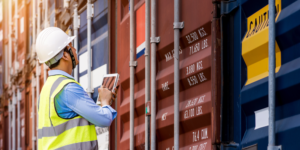
With so many options for insurance policies and coverages, it’s hard to know what contractors need to purchase and what they don’t. Inland marine insurance is one of those coverages that contractors should look into. It covers tools and equipment both in transit and at the job site — a gap you may not know that you have. We’ll look at what inland marine insurance is, what it covers, and why you should seriously consider purchasing it.
What is inland marine insurance?
Inland marine insurance, also called tools and equipment insurance, provides coverage for products, materials, and equipment when they are being transported over land or while they are stored temporarily at a jobsite or warehouse. It covers contractors’ tools, materials, and equipment when they are on the jobsite or being transported. It provides insurance coverage for movable assets that aren’t covered elsewhere, like in general liability or auto insurance policies.
The name comes because products transported by ship were covered under ocean marine insurance. Once products started being transported by truck, train, or bus, inland marine insurance was created.
What does an inland marine policy cover?
Inland marine insurance protects your tools, material, and equipment when it’s in transit or on a jobsite. You may think these items are covered by your general liability insurance. However, general liability only covers losses at the location listed on the policy. It does cover property damage and bodily injury claims but will not replace or repair damaged equipment or tools. For this type of coverage, you need an inland marine or tools and equipment policy.
The policy protects your tools and equipment from theft, damage, or vandalism, and will pay the cost to replace or repair the asset, plus temporary measures to keep the project on schedule. You may add additional coverage to include rented equipment, builders risk, equipment floater, or an installation floater. These added coverages will require additional premium payments, of course.
How much does it cost?
The median cost of inland marine insurance is approximately $14 per month, or $169 per year, according to Insureon.
Note that the cost of a policy is always subject to the asset value, coverage limits, the amount of risk in the industry, and your claims history. It’s best to contact an insurance agent to get a proper estimate before purchasing coverage.
Inland marine vs general liability insurance
Inland marine and general liability insurance cover similar assets, but in different locations. General liability insurance covers your equipment, tools, and materials at the site listed on the policy, usually the office or other central location. It covers your assets when they are in storage.
An inland marine policy covers them on the jobsite or in transit. It covers your assets when they are in action. Both coverages are of benefit to contractors and protect them from damages caused by their equipment and tools, as well as damage to their equipment and tools.
Another key difference is that general liability insurance is usually required for most contractors. Inland marine insurance is an optional coverage that is not required. Although, it’s a good idea for contractors to invest in it, as it protects them and their projects from delays and losses.
Inland marine vs mobile equipment insurance
Mobile equipment is equipment that fits any of the categories listed below:
- Bulldozers, farm machinery, forklifts, and other vehicles designed for off-road use
- Vehicles maintained for use on or adjacent to your premises (for example, a maintenance truck that never leaves your property)
- Vehicles that travel on crawler treads
- Vehicles, whether self-propelled or not, which are used to carry shovels, loaders, diggers, road construction, and similar equipment
- Vehicles that aren’t self-propelled that are used to carry compressors, pumps, generators, cherry pickers, and other equipment that is permanently attached (if self-propelled, such vehicles are considered autos)
- Vehicles that don’t fall into any of the previous categories and are used for purposes other than the transportation of persons or cargo
Mobile equipment, like tools and other equipment, is covered by multiple insurance policies. Mobile equipment can be covered under your auto insurance policy if it is being used on public roads.
Your general liability insurance covers any bodily injury or property damage caused by your equipment, no matter where the damage takes place. And inland marine covers any damage to the equipment, theft, or vandalism that takes place on a jobsite or while it’s in transit. The three policies combine to cover your equipment at all times.
